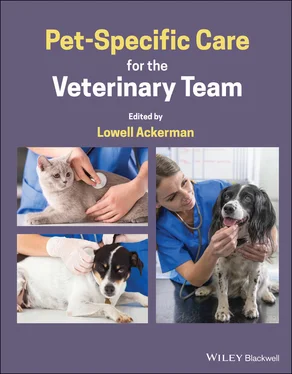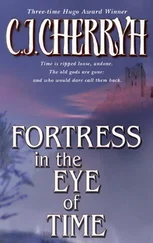 TAKE‐AWAYS
TAKE‐AWAYS
Genetic disease is observed every day in practice
Genetic counseling involves the treatment of mixed‐breed and purebred patients as well as prebreeding health evaluations.
The veterinary team should be knowledgeable about breed‐specific genetic disorders, especially those that can cause issues with anesthesia, surgery, and drug treatment.
Many breed‐validated disease‐causing genetic mutations occur at significant frequencies in breeds so that selection against them should be done in a systematic “breed and replace” manner so as not to affect the genetic diversity of the breed.
The veterinary team should impress upon clients that purposefully bred dogs and cats should only be obtained from health‐conscious breeders who perform prebreeding health screening and genetic testing.
 MISCELLANEOUS
MISCELLANEOUS
Abbreviations
OFAOrthopedic Foundation for Animals WSAVAWorld Small Animal Veterinary Association
1 Ackerman, L. (2011). The Genetic Connection: A Guide to Health Problems in Purebred Dogs, 2e. Lakewood, CO: AAHA Press.
2 Bell, J.S., Cavanaugh, K.E., Tilley, L.P., and Smith, F.W.K. (2012). Veterinary Medical Guide to Dog and Cat Breeds. Jackson, WY: Teton NewMedia.
3.9 Purebreds, Mixed‐Breeds, and Hybrids
Lowell Ackerman, DVM, DACVD, MBA, MPA, CVA, MRCVS
Global Consultant, Author, and Lecturer, MA, USA
 BASICS
BASICS
3.9.1 Summary
Veterinary teams need to be prepared for a variety of patients these days, with different breed names, descriptions, and predispositions to disease. It has never been more important to ensure that such pets are properly recorded in practice management software, as this can impact risk assessment and appropriate communication with pet owners.
Hybrid:Also known as a designer breed, this is a cross between two or more purebreds. In most cases, the cross is intentional.
Mixed‐breed:This is the result of a mix of breeds, potentially some known and others unknown. In most cases, the cross was unintentional. There are a variety of other terms for this, such as mutt in dogs and moggy in cats.
Pedigree:Recorded ancestry.
Purebred:An animal of a modern breed with a documented pedigree.
 MAIN CONCEPTS
MAIN CONCEPTS
In most veterinary practices, approximately half of all canine patients are mixed‐breeds (and an even higher percentage for feline patients), and there are approximately an equal number of purebreds or hybrids. If the information available in practice management software is to be useful for pet‐specific strategies, then it is critical that this information be correct in the medical record.
Purebred pets are those with a documented pedigree and there are literally hundreds of dog breeds and dozens of cat breeds in the world today. Many countries have organizations that recognize breed status and record pedigrees (e.g., American Kennel Club, The Kennel Club, United Kennel Club, etc.) and it is quite possible that some breeds recognized as purebreds by one organization may not be recognized by another (see 11.1Finding More Information on Pet‐Specific Care). There are also international organizations dealing with purebreds, such as the Fédération Cynologique Internationale ( www.fci.be) for dogs, and the International Cat Association (TICA) ( www.tica.org) and the Cat Fanciers Association ( www.cfa.org) for cats.
One of the most useful features of purebreds, from a pet‐specific care perspective, is that they tend to have more predictable behaviors and predispositions to disease (see 11.4Heritable Health Conditions – By Breed). Many behaviors are highly ingrained in a breed (e.g., retrieving, herding), and pet owners may have certain expectations in this regard. It is also easier to predict features such as personality in purebreds, adult size and, as mentioned, breed predisposition to certain diseases. In addition, there are a variety of genetic screening tests now available, and most are applicable to diseases recognized in certain purebreds (although some can also be detected in mixed‐breed and hybrid animals).
Hybrids are becoming more common in society, as breeders and pet owners attempt to select for specific features by crossing a variety of purebred breeds. While some breeders have attempted to create new purebred breeds from the offspring of these crosses, in general the hybrids involve the continued breeding of specific purebreds to attain the desired crosses. While there are many canine hybrids being promoted ( Table 3.9.1), some feline hybrids have also been developed, and some of these are now recognized as purebreds. These include the Savannah Brown, Ocicat, Oriental Shorthair, Tonkinese, Bengal, Chausie, Savannah, Pixiebob, and Toyger.
Table 3.9.1 Examples of some canine hybrid crosses
| Affenwich |
= |
Affenpinscher |
× |
Norwich terrier |
| Airedoodle |
= |
Airedale |
× |
Poodle |
| American Bull‐Jack |
= |
American bulldog |
× |
Jack Russell terrier |
| Ausky |
= |
Australian cattle dog |
× |
Siberian husky |
| Aussiedoodle |
= |
Australian shepherd |
× |
Poodle |
| Baussie |
= |
Australian shepherd |
× |
Boston terrier |
| Beabull |
= |
Bulldog |
× |
Beagle |
| Belusky |
= |
Siberian husky |
× |
Belgian Malinois |
| Biton |
= |
Bichon frisé |
× |
Coton de Tulear |
| Bogle |
= |
Beagle |
× |
Boxer |
| Borkie |
= |
Bichon frisé |
× |
Yorkshire terrier |
| Bostie |
= |
Boston terrier |
× |
West Highland white terrier |
| Bowzer |
= |
Basset hound |
× |
Miniature schnauzer |
| Cadoodle |
= |
Collie |
× |
Poodle |
| Cairnese |
= |
Cairn terrier |
× |
Havanese |
| Cavachon |
= |
Bichon frisé |
× |
Cavalier King Charles spaniel |
| Chorkie |
= |
Chihuahua |
× |
Yorkshire terrier |
| Chug |
= |
Chihuahua |
× |
Pug |
| Cocarpoo |
= |
Cocker spaniel |
× |
Poodle |
| Corkie |
= |
Cocker spaniel |
× |
Yorkshire terrier |
| Crustie |
= |
Chinese crested |
× |
Yorkshire terrier |
| Daug |
= |
Dachshund |
× |
Pug |
| Dorkie |
= |
Dachshund |
× |
Yorkshire terrier |
| Double Doodle |
= |
Goldendoodle |
× |
Labradoodle |
| Doxle |
= |
Beagle |
× |
dachshund |
| Eskland |
= |
American Eskimo |
× |
Shetland sheepdog |
| Goldendoodle |
= |
Golden retriever |
× |
Poodle |
| Jack‐A‐Bee |
= |
Beagle |
× |
Jack Russell terrier |
| Jug |
= |
Jack Russell terrier |
× |
Pug |
| Labradoodle |
= |
Labrador retriever |
× |
Poodle |
| Malt‐A‐Poo |
= |
Maltese |
× |
Poodle |
| Mastador |
= |
Labrador retriever |
× |
Mastiff |
| Mauxie |
= |
Dachshund |
× |
Maltese |
| Morkie |
= |
Maltese |
× |
Yorkshire terrier |
| Muggin |
= |
Miniature pinscher |
× |
Pug |
| Papastzu |
= |
Papillon |
× |
Shih tzu |
| Paperanian |
= |
Papillon |
× |
Pomeranian |
| Papichon |
= |
Papillon |
× |
Bichon frisé |
| Peke‐A‐Boo |
= |
Bolognese |
× |
Pekingese |
| Peke‐A‐Poo |
= |
Pekingese |
× |
Poodle |
| Peke‐A‐Tese |
= |
Maltese |
× |
Pekingese |
| Pekehund |
= |
Dachshund |
× |
Pekingese |
| Pinny‐Poo |
= |
Miniature pinscher |
× |
Poodle |
| Pitsky |
= |
American pit bull terrier |
× |
Siberian husky |
| Pom Terrier |
= |
Pomeranian |
× |
Toy fox terrier |
| Pomaky |
= |
Pomeranian |
× |
Siberian husky |
| Pomston |
= |
Boston terrier |
× |
Pomeranian |
| Poochon |
= |
Bichon frisé |
× |
Poodle |
| Poogle |
= |
Beagle |
× |
Poodle |
| Pookimo |
= |
American Eskimo |
× |
Poodle |
| Poolky |
= |
Poodle |
× |
Silky terrier |
| Puggle |
= |
Beagle |
× |
Pug |
| Pugottie |
= |
Pug |
× |
Scottish terrier |
| Rotterman |
= |
Doberman pinscher |
× |
Rottweiler |
| Schapso |
= |
Lhasa apso |
× |
Miniature schnauzer |
| Schnocker |
= |
Cocker spaniel |
× |
Miniature schnauzer |
| Schnoodle |
= |
Miniature schnauzer |
× |
Poodle |
| Sharbo |
= |
Boston terrier |
× |
Chinese shar‐pei |
| Snorkie |
= |
Miniature schnauzer |
× |
Yorkshire terrier |
| Spanador |
= |
Cocker spaniel |
× |
Labrador |
| Wauzer |
= |
Miniature schnauzer |
× |
West Highland white terrier |
| Yorkie‐Poo |
= |
Poodle |
× |
Yorkshire terrier |
| Yorkinese |
= |
Pekingese |
× |
Yorshire terrier |
| Zuchon |
= |
Bichon frisé |
× |
Shih tzu |
While initial crosses were touted as being healthier than the purebreds from which they were derived (so‐called hybrid vigor), it is now recognized that these crosses can still concentrate deleterious genes and may develop their own predispositions to disease. Some of these can even be detected with genetic screening in these hybrids.
Читать дальше

 TAKE‐AWAYS
TAKE‐AWAYS MISCELLANEOUS
MISCELLANEOUS BASICS
BASICS MAIN CONCEPTS
MAIN CONCEPTS










